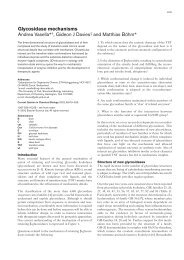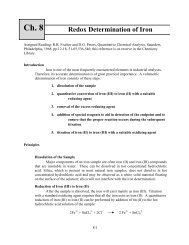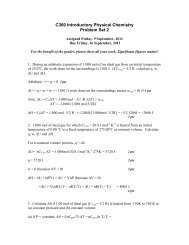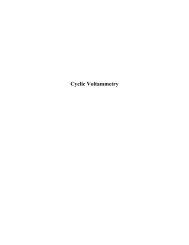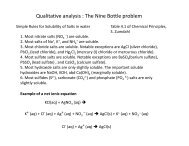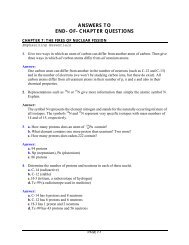ANSWERS TO END-OF-CHAPTER QUESTIONS
ANSWERS TO END-OF-CHAPTER QUESTIONS
ANSWERS TO END-OF-CHAPTER QUESTIONS
You also want an ePaper? Increase the reach of your titles
YUMPU automatically turns print PDFs into web optimized ePapers that Google loves.
. Average bond energies are based on bonds within molecules in the gaseous state. In the<br />
given chemical equation, the H2O formed is present as a liquid rather than as a gas.<br />
Additional energy is released when gaseous water condenses to the liquid state, so the stated<br />
value of 286 kJ is greater than the 249 kJ calculated in part a.<br />
25. Every year, 5.6 × 10 21 kJ of energy comes to Earth from the Sun. Why can’t this energy be<br />
used to meet all of our energy needs?<br />
Answer:<br />
Solar energy is distributed over Earth’s surface. Therefore, it is not very easy to capture,<br />
store, and transform solar energy to meet our energy needs.<br />
26. This unbalanced equation represents the last step in the production of pure silicon for use in<br />
solar cells.<br />
__Mg(s) + __SiCl4(l) ⎯→ __MgCl2(l) + __Si(s)<br />
a. How many electrons are transferred per atom of pure silicon formed?<br />
b. Is the production of pure silicon an oxidation or a reduction reaction? Why do you think<br />
so?<br />
Answer:<br />
a. This is the balanced equation: 2 Mg(s) + SiCl4(l) ⎯→ 2 MgCl2(l) + Si(s)<br />
Each magnesium atom loses 2 electrons, and there are 2 magnesium atoms providing<br />
electrons for one silicon atom. Silicon in SiCl4 picks up the four electrons.<br />
b. The silicon atoms in SiCl4 gain four electrons to form elemental silicon, a reduction<br />
process. The two magnesium atoms each lose two electrons, an oxidation process. Overall,<br />
the production of pure silicon is an oxidation-reduction reaction.<br />
27. The symbol represents an electron and the symbol represents a silicon atom. Does this<br />
diagram represent a gallium-doped p-type silicon semiconductor, or does it represent an<br />
arsenic-doped n-type silicon semiconductor? Explain your answer.<br />
Answer:<br />
Each Si atom is surrounded by 8 electrons, but the atom in the center (the one that is doping<br />
the semiconductor) is surrounded by 9 electrons. Silicon is in Group 4A and has 4 outer<br />
electrons. Thus central atom in the figure must have 5 outer electrons. This is consistent with<br />
an element in Group 5A such as arsenic, so this is an n-type silicon semiconductor.<br />
28. Describe the main reasons why solar cells have solar energy conversion efficiencies<br />
significantly less than the theoretical value of 31%.<br />
PAGE 8-8



